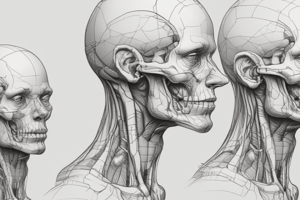Podcast
Questions and Answers
What is the primary function of the head?
What is the primary function of the head?
- To support and position the neck
- To regulate body temperature
- To house and protect the brain and sensory systems (correct)
- To facilitate movement of the upper limbs
What are the two vascular compartments in the neck responsible for containing?
What are the two vascular compartments in the neck responsible for containing?
- The larynx and pharynx
- The vertebral column and postural muscles
- The thyroid, parathyroid, and thymus glands
- The major blood vessels and the vagus nerve (correct)
What is the primary function of the neck?
What is the primary function of the neck?
- To facilitate movement of the upper limbs
- To regulate body temperature
- To protect the brain and sensory systems
- To support and position the head (correct)
What are the major compartments in the head?
What are the major compartments in the head?
What is contained in the visceral compartment of the neck?
What is contained in the visceral compartment of the neck?
What is the significance of the head and neck in relation to sensory systems?
What is the significance of the head and neck in relation to sensory systems?
What is the main function of the pharynx and larynx in the head?
What is the main function of the pharynx and larynx in the head?
How many bones are there in the skull, excluding the ossicles of the ear?
How many bones are there in the skull, excluding the ossicles of the ear?
What is the term for the upper domed part of the cranium?
What is the term for the upper domed part of the cranium?
Which bone forms the lower jaw?
Which bone forms the lower jaw?
What is the term for the raised arches on each side of the forehead, just superior to the rim of the orbit?
What is the term for the raised arches on each side of the forehead, just superior to the rim of the orbit?
Which bone forms the superior part of the rim of each orbit?
Which bone forms the superior part of the rim of each orbit?
Flashcards
Head and Neck
Head and Neck
Anatomically complex area comprised of several compartments formed by bone and soft tissues.
Head Compartments
Head Compartments
Cranial cavity, ears, orbits, nasal cavities, and oral cavity.
Neck Compartments
Neck Compartments
Vertebral, visceral, and two vascular compartments.
Head Functions
Head Functions
Signup and view all the flashcards
Neck Functions
Neck Functions
Signup and view all the flashcards
Bones of the Skull
Bones of the Skull
Signup and view all the flashcards
Cranium Subdivisions
Cranium Subdivisions
Signup and view all the flashcards
Anterior Skull Features
Anterior Skull Features
Signup and view all the flashcards
Frontal Bone
Frontal Bone
Signup and view all the flashcards
Frontal Bone Projection
Frontal Bone Projection
Signup and view all the flashcards
Zygomatic Process of Frontal Bone
Zygomatic Process of Frontal Bone
Signup and view all the flashcards
Study Notes
Head and Neck
- The head and neck are anatomically complex areas of the body.
- The head consists of several compartments formed by bone and soft tissues.
- These compartments are: the cranial cavity, two ears, two orbits, two nasal cavities, and an oral cavity.
Compartments of the Neck
- The neck has four major compartments enclosed by an outer musculofascial collar.
- The vertebral compartment contains the cervical vertebrae and associated postural muscles.
- The visceral compartment contains important glands (thyroid, parathyroid, and thymus) and parts of the respiratory and digestive tracts.
- The two vascular compartments, one on each side, contain the major blood vessels and the vagus nerve.
Functions of the Head and Neck
- The head houses and protects the brain and receptor systems associated with the special senses.
- The head contains the upper parts of the respiratory and digestive systems.
- The neck supports and positions the head, enabling an individual to position sensory systems in the head relative to environmental cues.
- The neck contains specialized structures (pharynx and larynx) that connect the upper parts of the digestive and respiratory tracts in the head with the esophagus and trachea.
Skull
- The skull has 22 bones, excluding the ossicles of the ear.
- The bones of the skull are attached to each other by sutures and are immobile.
- The cranium can be subdivided into the calvaria, base, and facial skeleton.
- The calvaria covers the cranial cavity containing the brain.
- The base of the cranium consists of the floor of the cranial cavity.
- The facial skeleton consists of the bones forming the face.
Anterior View of the Skull
- The anterior view of the skull includes the forehead, orbits, nasal region, face, upper jaw, and lower jaw.
- The frontal bone forms the forehead and the superior part of the rim of each orbit.
- The frontal bone projects inferiorly, forming a part of the medial rim of the orbit.
- The zygomatic process of the frontal bone projects inferiorly, forming the upper lateral rim of the orbit.
Studying That Suits You
Use AI to generate personalized quizzes and flashcards to suit your learning preferences.



